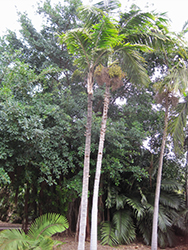It's all about ...
plants

Height: 20 feet
Spread: 15 feet
Sunlight:
![]()
![]()
Hardiness Zone: 8b
Other Names: Tibetan Arenga Palm
Description:
A multi-stemmed palm with large, flat, evenly pinnate leaves with silver undersides; impressively cold hardy, enduring light snow and freezes; highly adaptable to varied conditions; flowers rarely; an attractive landscape accent
Ornamental Features
Tibetan Sugar Palm has attractive dark green foliage with silver undersides on a tree with the bulk of the canopy held atop a towering trunk or stem. The narrow pinnately compound leaves are highly ornamental and remain dark green throughout the winter.
Landscape Attributes
Tibetan Sugar Palm is a multi-stemmed evergreen tree with a towering form, with a high canopy of foliage concentrated at the top of the plant. Its relatively coarse texture can be used to stand it apart from other landscape plants with finer foliage.
This tree will require occasional maintenance and upkeep, and should not require much pruning, except when necessary, such as to remove dieback. It is a good choice for attracting birds to your yard. Gardeners should be aware of the following characteristic(s) that may warrant special consideration;
- Insects
- Disease
Tibetan Sugar Palm is recommended for the following landscape applications;
- Accent
- Mass Planting
- Hedges/Screening
Planting & Growing
Tibetan Sugar Palm will grow to be about 20 feet tall at maturity, with a spread of 15 feet. It has a high canopy of foliage that sits well above the ground, and is suitable for planting under power lines. As it matures, the lower branches of this tree can be strategically removed to create a high enough canopy to support unobstructed human traffic underneath. It grows at a medium rate, and under ideal conditions can be expected to live for 60 years or more.
This tree does best in full sun to partial shade. It does best in average to evenly moist conditions, but will not tolerate standing water. It is not particular as to soil pH, but grows best in rich soils. It is somewhat tolerant of urban pollution. This species is not originally from North America, and parts of it are known to be toxic to humans and animals, so care should be exercised in planting it around children and pets.
This plant is not reliably hardy in our region, and certain restrictions may apply; contact the store for more information.
